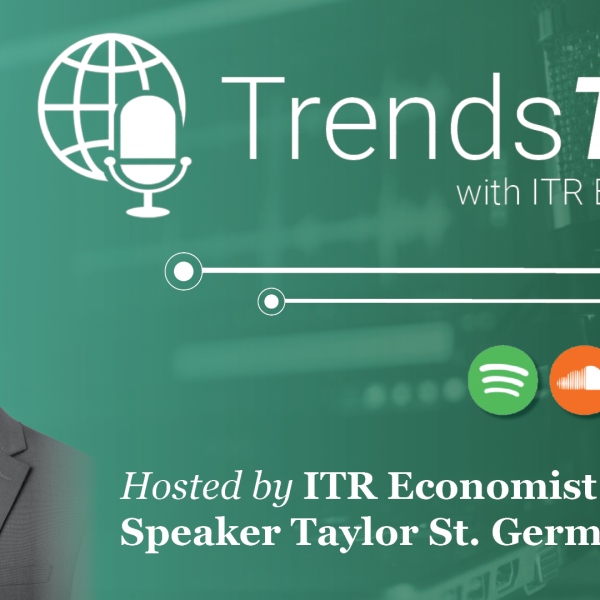- Mon - Fri: 8:30 - 5:00
- +1-603-796-2500
- ITR@itreconomics.com
August 18, 2023
- Home
- portfolio
- TrendsTalk
- August 18, 2023
with Taylor St. Germain
CHINA'S SLOWING GROWTH
Contrary to years past, China has recently been experiencing significant slowdown in their pace of growth. What challenges does this bring and what does it mean for their future? Tune in to a new episode of TrendsTalk with ITR Economist and Speaker Taylor St. Germain to find out!
The below transcript is a literal translation of the podcast audio that has been machine generated by Rev.
Hi everyone. My name’s Taylor St. Germain, and welcome to this edition of Trends Talk. I’m back in Colorado today from New Hampshire, actually headed to Chicago later today. So wanted to sneak in a Trends Talk with you all and chat a little bit about China today. Particularly looking at China’s growth now compared to where China has been in the future, and we’ve noticed quite the significant slowdown in the pace of growth that China’s been experiencing in recent years. One relationship we look at is the US Industrial Production Index to China’s Industrial Production Index, and we overlay the quarter-over-quarter growth rates with one another. Now, the US has been a developed economy for quite some time, typically growing somewhere between zero and 5%. Of course, different cycles, different growth rates, but generally speaking, in that low single digit or two mid-single digit growth rates, that’s very indicative of a developed economy.
However, when we look at China, for example, back in the early 2000s, it wasn’t unusual to see the 3/12 rate of change for China industrial production growing in the double digits, in the high double digits in terms of 15% to 20% range. And then as we move past the financial crisis, we started to see China’s pace of growth slow down on average. We saw growth rates more indicative of the high single digits, low double digits. And then when we look at China’s growth rates in the last three years, they’ve been a lot more closely aligned with the US industrial production growth rates. So what am I saying here? I’m suggesting that China is not growing at the pace that they used to two decades ago. When we look at present times, growth rates are more indicative of growth rates of other developed nations like the US.
So we’ve seen a significant slowdown in the growth rates that China has been able to achieve. Another really interesting way we understand China’s growth is by putting an index like industrial production on a log scale. By putting it on a log scale, we can really understand what this slope of growth looks like in China over time. And if you look at China’s data from say, 1996, all the way up until the financial crisis, you’d say, “Wow, China grows in almost a linear fashion when looking at the annual data trends.” However, in this post great recession era, post 2009 era, we can see that that slope has slowed down significantly. That linear trend that we might’ve seen back in the ’90s and early 2000s has not continued, and we’ve seen that slope bend or that slope weaken as we look at the last couple of decades.
Now, with the most recent data, we’re also seeing some downside pressure in China. And as we speak, really as we look at China’s industrial production, the performance of their consumer, we’ve seen some of the weakest growth rates in these indexes, whether it’s China industrial production or China consumer total retail sales over the last three years compared to the growth rates that we’ve seen, again, back over the last couple of decades. We’ve actually seen some negative growth rates out of China, industrial production in China consumer goods, retail sales over the last three years, really during this pandemic timeframe, post pandemic timeframe, where we hadn’t seen negative metrics throughout the data history. So really, this just goes to show that China is not able to sustain the growth that they’ve seen really for the last few decades. It’s slowed down in a really significant way. When we look forward, we do forecast China’s economy to grow out at about 3.8% for 2023, and that’s compared to 2022, and then slow down to 2.4% growth in 2024, followed by 3.5% in 2025.
So it’s clear from our forecast, we see this trend of China growing at a much slower pace, a lower rate continuing for the next few years. China faces demographic challenges. China faces challenges from a geopolitical standpoint with many countries around the world. And our president and CEO shared a lot of great information on China during their Great Depression webinar that they hosted a few weeks ago. Please reach out if you’d like to hear more about China, especially gaining access to that webinar. But it’s clear, China’s in a much different place today than where they’ve been throughout the last few decades, and we expect that to continue as we move forward. I hope you found that helpful. My name’s Taylor St. Germain on this episode of Trends Talk with ITR Economics, and I’ll see you on the next one.





